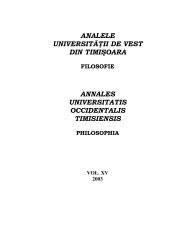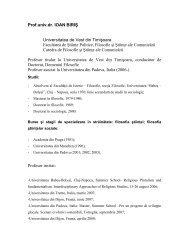VOL. IV (XXI) 2009 - Departamentul de Filosofie si Stiinte ale ...
VOL. IV (XXI) 2009 - Departamentul de Filosofie si Stiinte ale ...
VOL. IV (XXI) 2009 - Departamentul de Filosofie si Stiinte ale ...
You also want an ePaper? Increase the reach of your titles
YUMPU automatically turns print PDFs into web optimized ePapers that Google loves.
74 ON WITTGENSTEIN AND THE IMAGINARY NUMBER<br />
hermeneutics, I will en<strong>de</strong>avor to show the mystique of this alternative<br />
imaginary number, just like "inequalities" Śiva and “his Dance (Play)”.<br />
So what are we talking about here? ... First of all we know that<br />
Bombelli was quite inspired u<strong>si</strong>ng the neutral role of number 1. That is why<br />
multiplying this number helps to remove the negativity from the root of a<br />
negative number, which is known as universal mathematical formalism,<br />
represented as:<br />
√–a = √–1a = (√a)(√–1); iar √–1 = i => i² = –1;<br />
thus we have the following equiv<strong>ale</strong>nces:<br />
i = √–1; i² = –1; i³ = –i; i 4 = 1; i 5 = i etc.<br />
So without getting into other <strong>de</strong>tails on the complex numbers, what I<br />
propose does not follow this algoritm. Firstly, the starting point will be the rule<br />
of multiplication of <strong>si</strong>gns. As it is well known:<br />
+ + = +;<br />
– – = +;<br />
– + = – ;<br />
+ – = – ;<br />
From here one can ea<strong>si</strong>ly <strong>de</strong>duce that:<br />
+² = + ;<br />
–² = + ;<br />
–³ = – ;<br />
It follows that: √+ = (+ V –) and ³√– = – . Thus it appears that, in the<br />
present case, we can distinguish two kinds of +: i. e. that which we might call<br />
conventional maximum (absolute), from which we could draw only one other<br />
+ and the minimum (atomic), from which we can draw only one – . Due to<br />
this new agreement on the negative <strong>si</strong>gn we notice that it is the most ba<strong>si</strong>c<br />
up to now. This <strong>si</strong>gn is the "imparity" (especially on its exponents) and<br />
asymmetric par excellence, to the "structure" plus.<br />
In such a state of things let us notice what surprises could be brought<br />
by √–, bearing in mind that – it is the imparity par excellence. Therefore in<br />
this case we have P √–1, i. e. root (which is "parity" of or<strong>de</strong>r, i.e. even or<strong>de</strong>r)<br />
of something that is exponentially (for self-con<strong>si</strong>stency) only to the<br />
“imparity”(or odd numbers). The next step in this approach would be:<br />
P √– I = √– 3 = √– – 2 = –√– = –√– – 2 = +√– = +√– – 2 = – +√– = –√– … and so on;<br />
Then we could continue their equiv<strong>ale</strong>nts:




